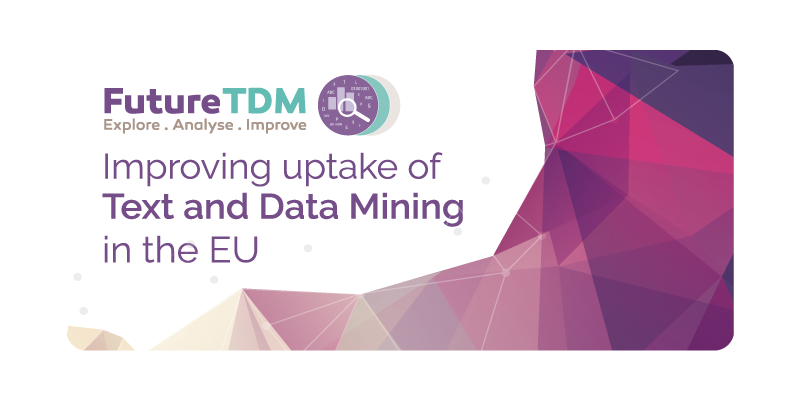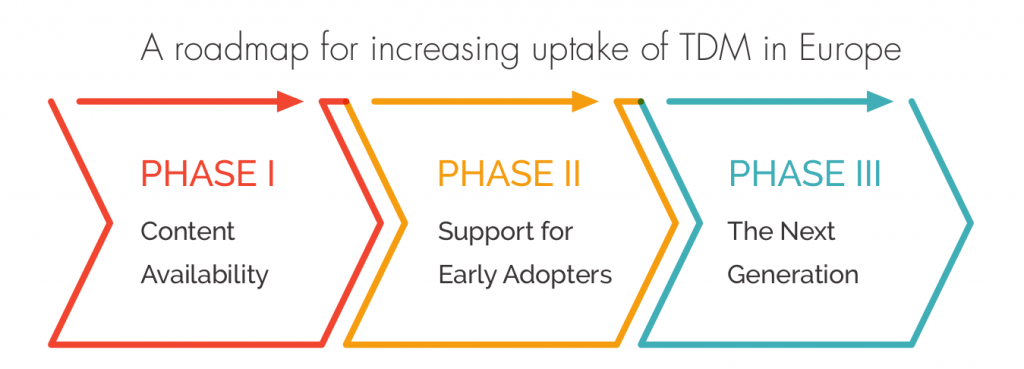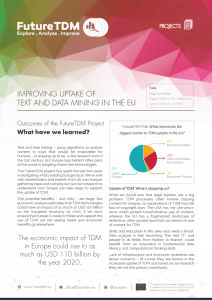This press release has been reposted from the FutureTDM website
Text and data mining – using algorithms to analyse content in ways that would be impossible for humans – is shaping up to be a vital research tool of the 21st century. But Europe lags behind other parts of the world in adopting these new technologies. The FutureTDM project has just concluded its’ two-year EC-funded research investigating what’s holding Europe back. The project consortium, consisting of 10 European partners led by SYNYO, met with stakeholders and experts from all over Europe, gathering input and carrying out research to understand how Europe can take steps to support the uptake of TDM. Open Knowledge International together with ContentMine led the work on communication, mobilisation and networking and undertook research into best practices and methodologies.

The potential benefits – and risks – are huge. According to the project’s economic analysis, TDM technologies could have an impact of as much as USD 110 billion on the European economy by 2020. If Europe is not ready to foster and support the use of TDM, the risk is seeing talent and economic benefits go elsewhere.

Legal barriers are a big problem. TDM processes often involve copying content for analysis, so applications of TDM may fall foul of copyright laws. The EU has a fragmented landscape of restrictive, often unclear laws that can restrict re-use of content for TDM. Skills and education in this area also need a boost. Data analysis is fast becoming “the new IT”, and people in all fields, from fashion to finance, could benefit from an education in fundamental data literacy and computational thinking skills. Lack of infrastructure and economic incentives are lesser concerns. More information on these barriers is available from the FutureTDM report Policies and Barriers of TDM in Europe.
FutureTDM put together real, practical proposals to support the uptake of TDM in Europe. These are summarised in a Roadmap for the EU which focuses on three key phases of support:

- Content Availability: making sure content is legally and practically discoverable and re-usable for TDM. Since rights clearance can be practically impossible for many TDM applications, it almost certainly means copyright reform to allow re-use of content that doesn’t trade on the original creative expression.
- Support Early Adopters: there is a need for initiatives that will connect TDM practitioners across domains and sectors, helping them share best practices and learn from each other’s experiences.
- The Next Generation: it is important to build a ‘data-savvy’ culture, where all Europeans have a fundamental awareness of the potential uses and benefits of data analytics.
 The platform at www.futuretdm.eu brings together all the results of the FutureTDM project. As well as databases of TDM projects, experts, methods and tools, the Knowledge Base includes a series of practical guidelines for stakeholders in the TDM landscape. These are resources offering straightforward, plainly-worded advice on legal, licensing, and data management issues – as well as on how universities in particular can play a key role in supporting the uptake of TDM in Europe. All outcomes are also summarised in the awareness sheet Outcomes of FutureTDM.
The platform at www.futuretdm.eu brings together all the results of the FutureTDM project. As well as databases of TDM projects, experts, methods and tools, the Knowledge Base includes a series of practical guidelines for stakeholders in the TDM landscape. These are resources offering straightforward, plainly-worded advice on legal, licensing, and data management issues – as well as on how universities in particular can play a key role in supporting the uptake of TDM in Europe. All outcomes are also summarised in the awareness sheet Outcomes of FutureTDM.
The FutureTDM project has received funding from the European Union’s Horizon 2020 Research and Innovation Programme under Grant Agreement No 665940.
For further questions please contact: office@futuretdm.eu / Tel +43 1 9962011
FutureTDM is an EU-funded research project that works on improving the uptake of Text and Data Mining (TDM) in the EU (2015-2017)








